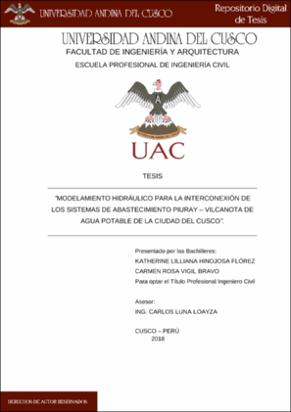| dc.contributor.advisor | Luna Loayza, Carlos | |
| dc.contributor.author | Hinojosa Flórez, Katherine Lilliana | |
| dc.contributor.author | Vigil Bravo, Carmen Rosa | |
| dc.date.accessioned | 2019-02-18T16:55:50Z | |
| dc.date.available | 2019-02-18T16:55:50Z | |
| dc.date.issued | 2018-10-24 | |
| dc.identifier.uri | https://hdl.handle.net/20.500.12557/2220 | |
| dc.description.abstract | Dentro de la ciudad del Cusco se tiene cinco sistemas de abastecimiento los cuales son
administrados por la EPS SEDACUSCO. Siendo los sistemas Vilcanota y Piuray los
más importantes, ya que brindan el servicio de agua potable a un 49.5% y 39.7% de la
población atendida, respectivamente; a comparación de los demás sistemas que
abastecen a un 10.8% en conjunto (Kor Kor, 6.1%; Jaquira, 1.1% y Salkantay, 3.6%),
considerando que estos sistemas tienen captaciones independientes, por lo que no se
consideraran dentro de la investigación.
Es por eso que se tiene como objetivo principal la determinación de una nueva
infraestructura que sirva para la interconexión de dichos sistemas en caso de emergencia
en alguno de estos, por medio de un modelo hidráulico. Debido a que se presentan fugas
en las líneas de conducción por la antigüedad del material de las tuberías. El tiempo de
reparación de estos oscila entre 12 – 23 horas dependiendo de diferentes factores.
Para poder determinar la infraestructura adicional se considera: la interrupción de
servicio en la línea de conducción por un periodo de 24 hr (considerando este tiempo
como el más crítico para culminar la reparación de una tubería) y tomando en cuenta la
producción de cada sistema como el caudal limite que se puede trasvasar.
Para poder desarrollar el modelo hidráulico se hizo uso de los planos de redes de
distribución y PAGIS brindados por la EPS SedaCusco, como también de los datos de la
tesis: “Determinación del coeficiente de variación de la demanda diaria y horaria de
agua potable de la ciudad del Cusco” realizada por Nicole A. Wilson G., y
posteriormente poder hallar el volumen facturado, el número conexiones activas. Con
estos datos se llegó a determinar el caudal promedio y el caudal máximo horario para
cada sistema.
Los resultados brindados por el modelo hidráulico nos sirvieron como base para poder
determinar la infraestructura necesaria para la interconexión de los sistemas; siendo este
una tubería de fierro fundido con 500 mm de diámetro, con un cambio de diámetro en la
tubería que va del reservorio de Koripata a Larapa, incrementando este a 700 mm.
Adicionando una bomba y una válvula reguladora de flujo, dependiendo el escenario de
emergencia que se pueda presentar. Teniendo 2 horas de trabajo simultaneo cuando la
emergencia se presenta en el sistema Vilcanota y 3 horas en caso contrario. | es_PE |
| dc.description.abstract | Having in the city of Cusco five systems of supply, systems administered by EPS
SEDACUSCO. The Vilcanota and Piuray systems being the most important, since they
provide drinking water service to 49.5% and 39.7% of the population served,
respectively; compared to the other systems that supply a 10.8% as a whole (Kor Kor,
6.1%, Jaquira, 1.1% and Salkantay, 3.6%), considering that these systems have
independent captures, so they were not considered within the research .
That is why the main objective is the determination of a new infrastructure that serves to
interconnect these systems in case of emergency in any of these, by means of a
hydraulic model. Because there are leaks in the lines of conduction by the antiquity of
the material of the pipes. The repair time of these ranges between 12 - 23 hours
depending on different factors.
To determine the additional infrastructure is considered: the interruption of service in
the line of conduction for a period of 24 hours (considering this time as the most critical
to complete the repair of a pipeline) and taking into account the production of each
system as the limit flow that can be transferred.
In order to develop the hydraulic model, use was made of the distribution network and
PAGIS plans provided by the EPS SedaCusco, as well as the thesis data:
“Determination of the coefficient of variation of the daily and hourly demand of
drinking water of the Cusco city “ Realized by Nicole A. Wilson G., and later to be able
to find the invoiced volume, the number of active connections. With these data, the
average flow and maximum hourly flow for each system was determined.
The results provided by the hydraulic model served as a basis to determine the
necessary infrastructure for the interconnection of systems; This being a cast iron pipe
with 500 mm in diameter, with a diameter change in the pipeline that goes from the
reservoir from Koripata to Larapa, increasing this to 700 mm. Adding a pump and a
flow regulating valve, depending on the emergency scenario that may arise. Having 2
hours of simultaneous work when the emergency occurs in the Vilcanota system and 3 hours otherwise. | en_US |
| dc.description.uri | Tesis | es_PE |
| dc.format | application/pdf | es_PE |
| dc.language.iso | spa | es_PE |
| dc.publisher | Universidad Andina del Cusco | es_PE |
| dc.rights | info:eu-repo/semantics/openAccess | es_PE |
| dc.rights.uri | https://creativecommons.org/licenses/by-nc-nd/2.5/pe/ | es_PE |
| dc.source | Universidad Andina del Cusco | es_PE |
| dc.source | Repositorio Institucional - UAC | es_PE |
| dc.subject | Modelamiento hidráulico | es_PE |
| dc.subject | Interconexión | es_PE |
| dc.subject | Sistemas de abastimiento | es_PE |
| dc.subject | Emergencia | es_PE |
| dc.title | Modelamiento hidráulico para la interconexión de los sistemas de abastecimiento Piuray – Vilcanota de agua potable de la ciudad del Cusco. | es_PE |
| dc.type | info:eu-repo/semantics/bachelorThesis | es_PE |
| thesis.degree.name | Ingeniero Civil | es_PE |
| thesis.degree.grantor | Universidad Andina del Cusco. Facultad de Ingeniería y Arquitectura | es_PE |
| thesis.degree.level | Titulo Profesional | es_PE |
| thesis.degree.discipline | Ingeniería Civil | es_PE |


